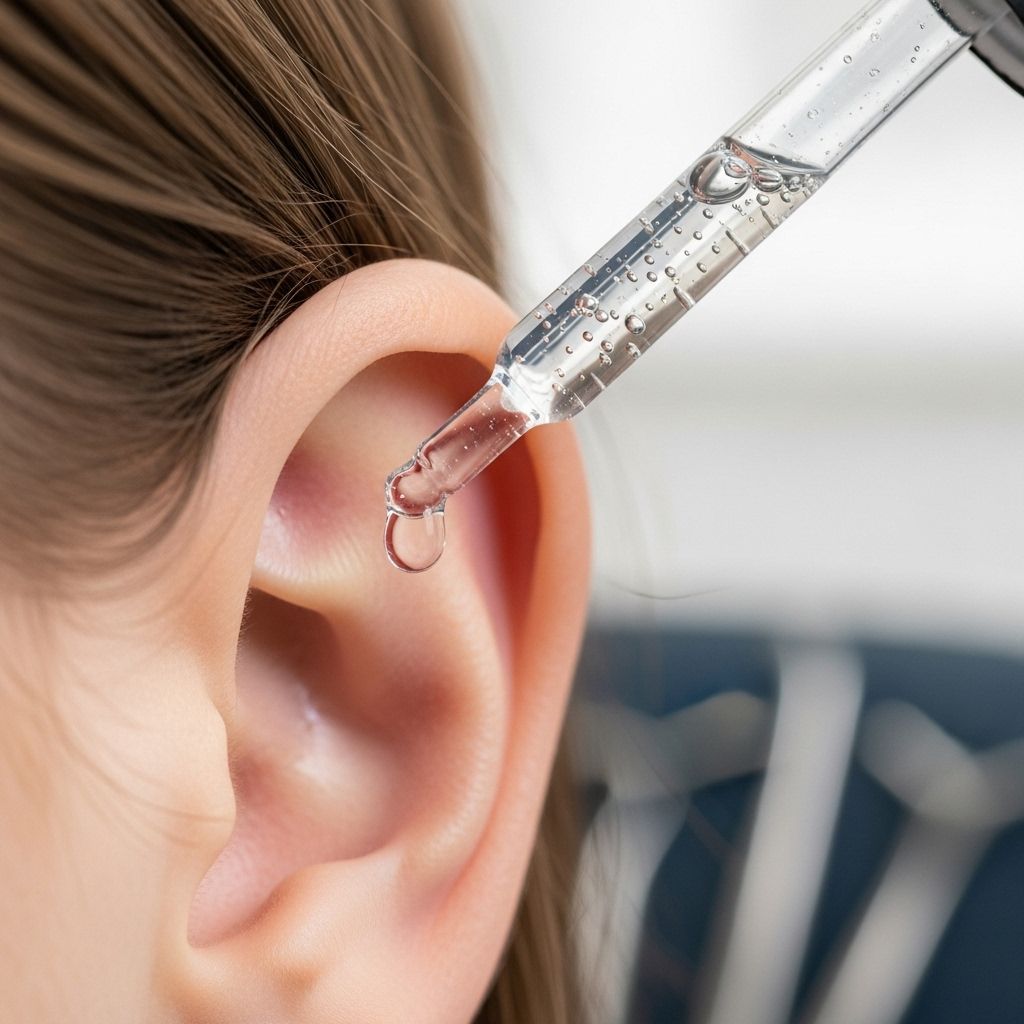Hydrogen Peroxide for Ear Wax: Uses, Benefits, Safety, and Precautions
Bubbling action can soften ear canal blockages without invasive tools.

Hydrogen Peroxide for Ear Wax Removal: A Complete Guide
Ear wax (cerumen) is a natural, protective substance produced in the ear canal, but sometimes it accumulates, leading to discomfort, hearing loss, or infection. Among the many home remedies for ear wax buildup, hydrogen peroxide is commonly used. This article explores whether hydrogen peroxide is truly effective and safe for cleaning your ears, the best practices, potential risks, and professional recommendations.
Understanding Ear Wax and Impaction
Ear wax plays a vital role in ear health by:
- Trapping dust, debris, and microorganisms
- Lubricating the ear canal
- Protecting the delicate skin from water and infection
Normally, ear wax works itself out of the ear through jaw movements like chewing or talking. However, issues arise when wax builds up and hardens, causing what is known as ear wax impaction. Common symptoms include:
- Muffled or reduced hearing
- Sensation of fullness in the ear
- Itchy ears or discomfort
- Ringing in the ear (tinnitus) or dizziness
- Earache or even infection in severe cases
What Is Hydrogen Peroxide and How Does It Work?
Hydrogen peroxide is a chemical compound (H2O2) commonly used as an antiseptic for minor wounds and as a cleaning agent. Its effectiveness in ear wax removal is due to its bubbling (effervescent) action, which occurs when it comes in contact with substances containing organic material like ear wax.
- Breaks down wax: The oxygen released helps soften and fragment hardened ear wax.
- Loosens debris: The bubbling lifts impurities and wax particles, making them easier to drain out.
- Flushes the ear: Softened wax is easier to remove through natural drainage or gentle rinsing.
Most over-the-counter ear drops with hydrogen peroxide use concentrations of 3% or less. Some drops use carbamide peroxide (which contains hydrogen peroxide) at around 6.5%.
Is Hydrogen Peroxide Safe for Ear Wax Removal?
When used properly, hydrogen peroxide can aid in softening and loosening ear wax, facilitating its removal or natural expulsion. However, experts caution that hydrogen peroxide:
- May not dissolve all types of wax completely; it primarily softens and breaks down the outer layer.
- Should only be used if you do NOT have an active ear infection, perforated eardrum, or ear tubes.
- Overuse or improper use can cause dryness, irritation, or even injury to the ear canal.
Expert Recommendations and Warnings
- Never use hydrogen peroxide if:
- You have an ear infection
- Your eardrum is perforated (has a hole)
- You have ear tubes in place
- Limit use: Occasional application (not daily) is best to minimize risks of irritation or dryness.
- Consider professional assessment if you are unsure about your symptoms or condition.
How to Use Hydrogen Peroxide for Ear Wax Removal: Step-by-Step Guide
Before you try any home ear cleaning method, consult a healthcare provider, especially if you have symptoms of infection or a history of ear problems. To safely use hydrogen peroxide for ear cleaning at home, follow these detailed steps:
- Gather Your Supplies:
- 3% hydrogen peroxide solution (never higher concentrations)
- Dropper or syringe (not needle-tipped)
- A clean towel or tissue
- A small bowl or basin for catching any fluid, if desired
- Prepare the Solution:
- If you have sensitive skin, dilute hydrogen peroxide with equal parts lukewarm water.
- Position Yourself:
- Lie on your side or tilt your head so the affected ear faces upward.
- Administer the Drops:
- Use the dropper to add 3-5 drops of the solution into the ear.
- Avoid forcing the dropper inside your ear canal.
- Let It Work:
- Stay in position for 5-10 minutes, allowing the bubbles to break down the wax.
- You may hear fizzing or popping sounds; this is normal.
- Drain and Clean:
- Sit up and lean your head to the opposite side to let the solution and loosened wax drain out onto a towel.
- Rinse (Optional):
- If directed by a healthcare professional, gently rinse your ear with warm water using a bulb syringe.
- Dry Your Ear:
- Pat the outside of your ear gently with a towel or tissue.
Repeat the process for the other ear if needed. Do not repeat more than twice a week without consulting a doctor.
Benefits of Using Hydrogen Peroxide for Ear Wax
- Widely available: 3% hydrogen peroxide is easy to obtain and inexpensive.
- Non-invasive: No need for sharp instruments inside the ear canal.
- Softens and mobilizes wax: Helps make at-home or professional removal simpler.
- May help with minor debris: Useful for mild wax buildup without complications.
Side Effects and Precautions
Always be aware of potential side effects and safety measures when using hydrogen peroxide in your ears:
- Irritation and dryness: Overuse can dry out the sensitive skin of the ear canal.
- Mild stinging or fizzing: Brief fizzing is normal, but pain is not. Discontinue use if pain or burning occurs.
- Ear canal injury: Aggressive use or excessive volume might irritate tissues or cause inflammation.
- Temporary hearing changes: Fizzing and dissolved wax may briefly impact hearing until wax is fully removed.
- Infection risk: Hydrogen peroxide should not be used with existing ear infections or eardrum perforations, as it can worsen the condition.
When to Avoid Hydrogen Peroxide in the Ear
- Active ear infection (pain, fever, discharge)
- History of eardrum perforation
- Ear tubes (tympanostomy tubes)
- History of ear surgery
- Allergy to hydrogen peroxide
- Children under age 3, unless directed by a pediatrician
Alternatives to Hydrogen Peroxide for Ear Cleaning
If hydrogen peroxide is not suitable for you, several other options exist for ear wax removal:
- Oil-based drops: Olive oil, almond oil, or mineral oil can safely soften wax for easier removal without the bubbling effect.
- Water-based solutions: Saline, sodium bicarbonate, and commercial ear drops designed to dissolve and hydrate wax.
- Carbamide peroxide drops: Often more effective as they combine wax softening with breakdown properties.
- Professional microsuction: Safest option for removing impacted or stubborn wax, especially for those with ear conditions.
Do not: Attempt DIY ear candling, dig into your ear with Q-tips, hairpins, or other objects—these can push wax deeper and risk injury.
What Do Experts Say?
Medical professionals have mixed opinions regarding hydrogen peroxide for ear wax:
- Some audiologists and ENTs discourage home use due to the risk of pushing wax deeper or causing irritation.
- They often advise using specially formulated OTC ear drops containing hydrogen peroxide or carbamide peroxide, which are tested for safety.
- Professional cleaning is preferred for those with a history of ear problems, frequent blockages, or symptoms of infection.
Table: Comparison of Common Ear Wax Removal Methods
| Method | Main Action | Pros | Cons |
|---|---|---|---|
| Hydrogen Peroxide Drops | Bubble and soften wax | Affordable, widely available, non-invasive | Not for infected or damaged ears, irritation possible |
| Oil-based Drops | Lubricate and soften | Gentle, minimal irritation | May be less effective for hard wax |
| Carbamide Peroxide Drops | Bubble, soften, break down wax | Effective, available OTC | Can cause irritation, not for all users |
| Professional Microsuction | Physically removes wax | Quick, safe, low risk when done by professionals | Requires clinic visit, higher cost |
| Ear Candling | Claims to pull wax via suction | None (not scientifically supported) | Dangerous, can cause burns and blockages |
Frequently Asked Questions (FAQs) About Hydrogen Peroxide and Ear Wax
Q: How often can I use hydrogen peroxide in my ears?
A: Limit application to one or two times per week as needed. Frequent use can lead to dryness, irritation, or worse. If wax buildup recurs often, seek medical advice.
Q: Are there side effects to hydrogen peroxide ear cleaning?
A: Brief fizzing and mild tingling are normal, but burning pain or persistent discomfort are not. Stop use if you notice these and contact a healthcare provider.
Q: Is it safe to use in children?
A: Children’s ear canals are delicate. Do not use in children under age 3, or in any child, without consulting a healthcare provider first.
Q: What if hydrogen peroxide does not clear my ear wax?
A: If symptoms persist, avoid repeated self-treatment. Consult an audiologist or ENT, as impacted wax may require professional removal or may indicate another condition.
Q: What concentration of hydrogen peroxide is safe for ear wax removal?
A: Always use a 3% solution or lower. Higher concentrations are caustic and will damage ear tissues.
Q: Is hydrogen peroxide more effective than other ear drops?
A: Some studies and expert opinions suggest that certain products, such as those containing carbamide peroxide or specialized ear wax dissolvers, may be more effective and less irritating than plain hydrogen peroxide.
Key Takeaways
- Hydrogen peroxide can be effective for softening and loosening non-impacted ear wax when used properly.
- Always follow instructions and never use in the presence of infection, a perforated eardrum, or ear tubes.
- Do not overuse. Repeated or excessive application increases risk of irritation and injury.
- If ear wax blockage persists or you experience pain, hearing loss, or discharge, contact a medical professional.
When to See a Doctor
- Persistent symptoms after attempting home treatment
- Signs of infection (pain, redness, fever, drainage)
- History of chronic ear problems or surgeries
- Uncertainty about your symptoms or ear health
Professional evaluation ensures safe, effective, and immediate relief while protecting your overall ear health.
References
- https://hearingup.com/videos/stop-using-hydrogen-peroxide-to-remove-earwax
- https://www.kentuckianaent.com/news/is-hydrogen-peroxide-safe-for-your-ears-what-experts-say
- https://www.houseclinic.com/home/blog/hydrogen-peroxide-to-treat-earwax/
- https://www.earworx.com.au/ear-cleaning/alternative-methods/hydrogen-peroxide/
- https://www.medicalnewstoday.com/articles/322725
- https://www.healthline.com/health/ear-wax-removal-hydrogen-peroxide
- https://www.mdanderson.org/cancerwise/how-to-clean-your-ears-safely–tips-to-avoid-harm.h00-159774867.html
- https://pmc.ncbi.nlm.nih.gov/articles/PMC1324923/
- https://www.uclahealth.org/news/article/6-things-you-need-know-about-earwax-removal
Read full bio of Sneha Tete












